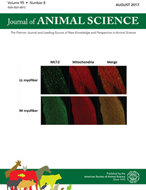-
Views
-
Cite
Cite
D. S. Lough, M. B. Solomon, T. S. Rumsey, S. Kahl, L. L. Slyter, The effects of high-forage diets with added palm oil on performance, plasma lipids, and carcass characteristics of ram lambs with initially high or low plasma cholesterol, Journal of Animal Science, Volume 72, Issue 2, February 1994, Pages 330–336, https://doi.org/10.2527/1994.722330x
Close - Share Icon Share
Abstract
The objectives of this study were to examine the interaction between added palm oil in high-forage diets and initial concentration of plasma cholesterol on performance, plasma lipids, and carcass characteristics of growing ram lambs. Thirty-two Hampshire-Suffolk ram lambs (initial BW = 34.4 kg) were assigned to a 2 × 2 factorial design consisting of diet (basal [NPO] or 10.7% added palm oil [PO]) and initial plasma cholesterol concentration (high x̅ = 50 mg/dL [HC] or low x̅ = 38 mg/dL [LC]; SEM = 2; P = .01). The lambs were individually fed diets (77% forage-23% concentrate) that contained 16.0% CP, 2.14 Mcal of ME/kg (NPO), and 2.62 Mcal of ME/kg (PO). Metabolizable energy intakes were adjusted to .20 Mcal/kg of BW75 for both dietary treatments. Lambs were weighed and feed intakes adjusted weekly. Lambs were bled via jugular venipuncture on d 28, 56, and 84 and lambs were slaughtered after they had been fed the diets for 90 d. Plasma concentrations of total cholesterol, high-density lipoprotein cholesterol, triglycerides, and nonesterified fatty acids were increased (P = .01) by feeding PO. Lambs fed PO were fatter than lambs fed NPO, as indicated by greater subcutaneous fat thickness and kidney and pelvic fat. Initial plasma cholesterol concentration had little effect on any of the parameters measured. Lambs fed PO had fatter carcasses than lambs fed NPO at calculated equalized ME intakes, which indicates that energy deposition is more efficient in palm oil-supplemented diets.





